Table of Contents
After nearly two years of intense warfare, Israel has announced plans to reduce its reservist forces. This strategic shift follows a U.S.-brokered cease-fire that appears to be holding, marking a significant transition from a state of high-intensity conflict to one focused more on potential peace and recovery.
The recent hostilities have impacted Israel’s military personnel, many of whom have been on active duty for extended periods. Consequently, the decision to lessen the reliance on reservists is seen as a necessary step to recuperate and reallocate military resources more effectively.
The impact of the cease-fire
The cease-fire established between Israel and Hamas has created a fragile tranquility in the region. This temporary cessation of hostilities has allowed both sides to reassess their positions and explore the possibility of a more enduring peace.
Although tensions remain, the cease-fire has provided a vital pause in the violence that has plagued the area.
Resuming relations and humanitarian efforts
With the cease-fire in effect, Israel has also begun addressing humanitarian concerns by returning the remains of Palestinian individuals to Gaza.
Recently, the Israeli government handed over the bodies of thirty Palestinians as part of a larger exchange agreement. This gesture is significant for the families of the deceased and plays a role in easing tensions between the two parties.
This transfer aligns with the stipulations of the cease-fire, which dictates that for every deceased hostage returned by Hamas, Israel is obligated to return a certain number of Palestinian remains.
With this recent exchange, the total number of bodies returned to Gaza has reached 225, signaling a step towards healing the wounds inflicted by the conflict.
The complexity of the situation
While the cease-fire has introduced an element of calm, many analysts argue that it merely disguises the underlying issues fueling the conflict.
The situation remains precarious, and experts note that stability could be fleeting. The current lull in violence may lead to a resurgence of hostilities if core grievances are not addressed.
Challenges for international diplomacy
Efforts by Western diplomats to facilitate a long-lasting resolution have faced significant challenges. The delicate balance between disarmament and military withdrawal remains contentious. The complexities of regional politics often hinder fruitful dialogue, making it difficult to achieve sustainable peace.
In a broader context, the dynamics extend beyond Gaza to other areas, including Lebanon, where similar tensions exist. These interconnected conflicts emphasize the need for a comprehensive approach to peace, one that acknowledges the multifaceted nature of the issues at play.
As the international community observes developments in Gaza, it becomes increasingly clear that the road to peace is fraught with obstacles. The cease-fire may provide temporary relief, but without a concerted effort to tackle the root causes of the conflict, the region may once again find itself in a cycle of violence.
Israel’s decision to draw down its reservist forces and the ongoing humanitarian gestures represent steps in the right direction. However, the complexities of the situation demand a persistent and nuanced approach to diplomacy that seeks to understand and resolve the deeper issues underlying the conflict.





